 Short Take Road Test
Short Take Road Test

When pondering the prices of the Volkswagen CC and the Toyota Camry or Honda Accord, mid-size-sedan buyers might ask themselves why the VW costs so much more. Well, we could draw you a picture of some dudes and a lady with a big butt hanging out in a park, but it wouldn’t be Georges Seurat’s Sunday Afternoon on the Island of La Grande Jatte. To simplify, one is art and the other is not, and you can guess which commands a premium.
The CC qualifies as art not because of its mechanicals—they come courtesy of the fine Passat—but because of its sublime design. Take the front seats, for example. They’re beautiful. The unbroken, curved sections that frame the bottom cushions are particularly daring compared with regular car seats, and the seats as a whole serve as a great example of how interesting design doesn’t have to impinge on functionality or comfort; they strike just the right balance between sporty grippiness and long-haul cushiness. Styling permeates everything else, too. Even the trench that hides the windshield vents was clearly carefully considered, adding a bit of drama to the forward view. And the fit and finish of everything is impeccable. There are adequate interior bins and cubbies for storage, including two drawers above the nav screen good for thinner items. (We liked to race the drawers against each other to see which would open quickest. Right always won; left now has an inferiority complex.)
The two rear seats (this is a four-seater; for a similarly sized five-seat VW, you’ll still need to go to the Passat) are handsome to look at and are split by a console with two cup holders and a bin that can all be hidden under a tambour cover. Those rear chairs have really nice side bolstering, long bottom cushions, and good legroom for regular adults. The downsides: Headroom is nil for six-footers even though the seats are mounted low, and stretching your legs to take advantage of the thigh support results in your toes banging into stuff under the front seats. The low roofline makes ingress and egress tricky, too.
But, oh, that roofline. It might cramp scalps inside, but it’s sleek and sexy outside. The CC’s exterior aesthetic is clean and uncluttered, which lets the overall shape—and that roof—do the talking, rather than fussy details or overwrought brand cues. The CC’s face is both angry and playful, and we love the sinewy bulge that drops from under the headlamps to form the lower boundary of the grille.
It Isn’t Just Good to Look At
So, yes, the CC looks fantastic, but this looker drives well, too. The 200-hp, 2.0-liter turbo is one of our absolute favorite engines. The four-cylinder provides its full 207 lb-ft of torque from a broad 1700 to 5000 rpm, and we love the faint whoosh—you can’t hear it if the radio is at even low volume—it makes on acceleration and throttle lift. The one minor complaint concerns the 2.0-liter’s gruffness, which is playful in the GTI but is a bit out of place here; one of our passengers asked if the CC were a diesel. But the sound never becomes bothersome and is quickly ignored, especially once you tramp the gas pedal and get moving.
Sixty mph comes up in seven seconds flat, impressive when you consider we couldn’t ring quicker than 6.2 seconds out of a 280-horse, V-6–powered CC, and that car had the benefit of launch-enhancing all-wheel drive. This front-driver makes up some of the accelerative gap by the time a quarter-mile has passed, running 15.3 seconds at 92 mph versus the burlier model’s 14.8 at 97. In our hands, the CC returned a healthy 25 mpg in mixed driving.
In our 2009 test car, the 2.0T was hooked to a six-speed Tiptronic automatic. There’s a manual mode, but the gate is to the right, making it a difficult reach for the driver during spirited driving. We stuck with dropping the shift lever in S (sport) when we felt a little bit saucy. But a little bit saucy is all you’ll get, as throttle response is too languid for all-out runs and the Tiptronic is too eager to upshift even in sport mode. The 2010-model-year 2.0T has the rapid-fire dual-clutch DSG also found in the GTI, so responses are likely to be better.
Brake-torque launches with the stability control off bring no torque steer, which is all but nonexistent pulling hard out of a corner. Entering a corner, however, is where you’ll encounter a couple of the CC’s small handful of weaknesses. Turn-in is reluctant—to be expected with nearly 60 percent of the car’s 3387 pounds hanging over the front axle—and the steering has little feel, although it is accurate.
The other demerit concerns a choppy ride over broken pavement, which is sort of surprising given the relatively tall sidewalls of our car’s 235/45-17 Continental ContiProContact tires. But such surfaces never really disturb the car’s attitude, and in all other situations, the ride is very controlled. Stability is rock solid even nudging triple-digit territory.
You Get What You Pay For
With this car, price is always going to be the sticking point. A base CC is about 28 grand, which is where the price structures of mainstream family sedans generally end. But the thing is, although those cars do the job and some are even fun to drive, they go about their business humbly, and you see dozens of them come and go every day. The CC is like a microbrewed beer or an IWC timepiece or, well, a painting by Georges Seurat. Sure, you could have a Bud, buy a Timex, and hang that big-butt-lady drawing on the wall—and those are all fine in their own way—but those who pay a little extra are usually rewarded with something extra, too. In the case of this VW, it’s high style.